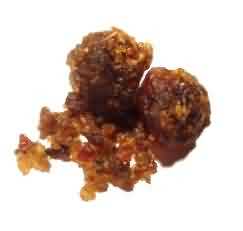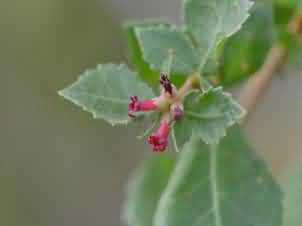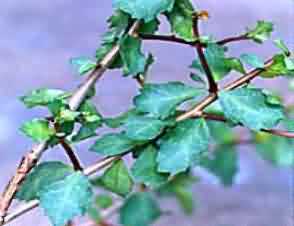गुुगल उगानें की विस्तृत जानकारी

Guggal or Indian bdellium, is a large spinescent shrub to a small tree, inhabiting drier parts of western India. Guggal cultivation is done mainly in Rajasthan and Gujarat. Its gum-resin is used in Ayurvedic medicines as a remedy to reduce cholesterol content in blood. It has also utility in treatment of arthritis and obesity. A large plantation of guggal exist in Ajmer district of Rajasthan.
Description of Guggal Plant
The plant is a woody shrub with knotty, crooked, sping brown bracties, leaves 1-3 foliate leaf lets, sessile with serrated margin. Flowers are pinkish unisexual. Fruit is drops red, ovate with two celled stone. The ash coloured bark comes off in flakes exposing the under bark which also peels off in thin papery tolls. The shrub defoliates in winter and reserves for guggul gum extraction is high during April-May.
Climate and Soil for guggal cultivation
It usually occurs in hills and piedomonts, but it can be grown in warm and semi and regions on hill tops, preferring hard, rocky soils of North West India. It is also considered as a drought aria salinity resistant plant. It prefers loams to sandy loam soils with pH ranging between 7.5 to. 9.0. Soils are coarse textured, well drained and calcarious soils are generally poor in organic carbon, nitrogen, high in potash ion, magnesium, zinc and copper, medium in phosphorus and calcium.
Propagation of guggal
There is no commercial variety identified or evolved for its commercial plantation. A new plantation can be raised from seeds and semi-woody stem-cuttings.
I. By Seed
Seeds are the major propagation source in nature. In Rajasthan and nearby arid regions flowers and seeds are constantly produced by C wightii except in winter season. April - May seeds are less viable compared to July to September seeds. Monsoon season creates conducive atmosphere for germination.
2. By Cuttings
It can be successfully propagated vegetatively by stem cuttings. Cuttings are planted in June at a depth of 15 cm for raising them in nursery. Proper soil moisture is necessary for better rooting. The rooting begins after 21 days from 30 cm long stem cutting having 1.5 - 2.0 cm diameter IBA @ 250 ppm treatment of stem cuttings is beneficial which enhances the rooting to nearly 70% as against 30% under normal conditions. The plants are kept in nursery for 6 months and during the monsoon rooted cutting are transplanted in the field at a spacing of 2 x 2 meters.
Field preparation
The land for field planting is well prepared, giving deep ploughing. The soil is exposed to hot sun for weathering to desiccate all pereदniating weeds. It is given 20 kg of Aldrin (10%) at land preparation to protect the plants from termite attack. The pits of 50cm × 50cm × 50cm size are dug out at 2m × 2m spacing, accommodating 2,500 plants/ ha. The pits are filled with well-rotten farmyard manure mixed with a table spoon full of Aldrin or Gamaxine. The pits are given soaking irrigation before planting, followed by one irrigation/month till next rainy season. Use of N and P does not give any positive response either on growth or gum yield. But low level of irrigation gives positive response in registering high rate of growth in Rajasthan and Gujarat.
Irrigation and Weeding
C. wightii require meager irrigation after its establishment. In the scarcity of rain, tip to 5 years, plant is in need of irrigation during winter season. During summer seasons at the age of 8 years when the plant attains full maturity it requires irrigation at least 2-3 times during summer and winter season. During rainy season, weeds occur in the crop. The excessive weeds-cheek the nutrition supply to the plant. The weeding is beneficial in the month of September and December.
Pruning guggal
Wherever, annual pruning of lateral branches is carried (leaving only 2–4 branches), the bushes attain better height and larger girth of main trunk and lateral branches in a shorter duration. The plantations are given 1–2 weeding-cum-hoeings in a year.
Tapping and Collection of guggal
The plants attain 3–5m height in 7–8 years and 3–4cm thick main trunk and some lateral branches. The trunk is ready for tapping during autumn season (December–February). The tapping is done by giving 9–11cm long triangular or circular cut, 40cm above the ground. The depth of the cut should never exceed the thickness of the bark, as resin ducts inhabit this part and may injure pholem and cambium part, causing damage to trees besides obstructing outflow of gum-resin. A paste of gum-resin in water is applied at the incised spot and bandaged to potentiate flow of gum-resin (guggal). The flow of gum starts 3–7 days after tapping and is exhausted in next 15–20 days. Since gum-resin gets hardened on exposure to air, it is collected in earthen cups fixed below the cut part. Two to three collections of gum are possible in a season. Use of 40mg of ethephon (2-chloroethyl phosphoric acid) fed to the roots through injection can increase the flow of gum and maximize yield significantly. The yield of a tree may vary from 200–500g/ season. However, tapped branches or the entire tree die 8–10 months after yielding the gum.
Grading of guggal
The best grade of guggul is collected from the thick branches of tree. These lumps of guggul are translucent Second grade guggul is usually mixed with brark, sand and is dull coloured guggul. Third grade guggul is usually collected from the ground which is mixed with sand stones and other foreign matter. The final grading is done after getting clearnsed material. Interior grades are improved by sprinkling castor oil over the heaps of the guggul which impart a shining appearance.
Plant Protection in guggal
Plants are often affected by termites particularly in summer season. Termite causes severe damage to the plant by making holes through buried ends of the stem or root. The infested plants become dry showing yellow appearance' of leaves and eventually result in death of the plants.
Some of the control measures are as follows
- Destroying the termitorium by using kerosene of calcium disulphide.
- Use of mercuric chloride (0.25 %) or copper sulphate (0.55%) in aquous solutions is effective in controlling the termites.
- Dusting of 250 gm of gamaxene (B.H.C. 10 %) in the soil of each pits at the time of planting is also used as preventive measures for termites.
Yield of guggal
Starting from sixth year the guggul gum yield increases from 200 gm to 400 gm per plant. The total guggul gum yield within five year comes to be 1600 gm per plant corresponding to 3200 kg per ha @ 2000 plants per ha.

Guggul flower

Guggul Plant
Authors
Rohini,N.,1* , N. Pandiarana2
1Ph.D., Research Scholar, Department of Vegetable crops, HC &RI, TNAU- 641003
2 Ph.D., Research Scholar, BCKV, Kalyani, West Bengal-741235
*Corresponding Author’s e-mail:
